Creating impactful buyer personas is a methodical process that transforms raw data into a strategic asset. It is not about guesswork or invention; it is about rigorous research and synthesis. This five-stage blueprint provides a clear path from initial data gathering to full organizational adoption.
1. Conduct quantitative research.
To ensure your buyer personas are accurate, you need to collect quantitative data. Use analytics, audience segmentation tools, and market research to analyze your customer base. The specific information you collect will depend on your industry and goals, but a strong buyer persona is typically built from the following data points:
- Demographics: Collect foundational information to sketch the basic outline of your buyer persona. This includes data like age, gender, race, location, industry, and company size. While not every customer will fit a single mold, this data identifies the common attributes of people interested in your offerings.
- Psychographics: Go beyond demographics to understand the internal traits that give your buyer persona personality. This data includes hobbies, lifestyle choices, motivations, and values. Website analytics can offer valuable quantitative insights into these preferences.
- Revenue and transaction data: Understand the financial value associated with your buyer persona. Track KPIs like average spend, lifetime value (LTV), and annual contract value. This data helps you qualify leads; if your target buyer persona typically has a budget of $5,000, you can quickly identify prospects who aren't a good fit.
- Social Media Data: Platforms like LinkedIn are a gold mine of quantitative data for building a professional buyer persona. Analyze job titles, skills, industry experience, and professional interests to add another layer of detail.
2. Improve buyer personas with qualitative research.
Quantitative data provides the "what," but qualitative data provides the "why." To create a truly empathetic and accurate buyer persona, you need to understand the human experience behind the numbers.
Conduct employee interviews.
Your customer-facing teams interact with your audience daily. Interview employees from sales, marketing, and customer service to add their frontline perspective to your buyer persona. Ask them:
- What are the top complaints and pain points you hear?
- What features or aspects of our service do customers rave about?
- What did customers try before switching to us?
- What is a common request we haven't been able to address?
Conduct Customer Interviews.
The best way to understand your audience is to speak with them directly. Interviewing your customers provides the most authentic details for your buyer persona. Find candidates by checking your CRM for top accounts or asking your team to recommend loyal, engaged customers. During the interview, ask questions that will flesh out your buyer persona:
- Can you describe your role and its main goals or KPIs?
- What are the most significant pain points you face in your role?
- How do you use our product to solve those problems?
- What do you look for when choosing a solution like ours?
3. Analyze quantitative and qualitative data to define buyer personas.
With your quantitative and qualitative data collected, it's time to synthesize it. Look for major trends and patterns to distinguish the separate segments within your audience. Each significant segment represents a potential buyer persona.
Look for patterns in the following areas:
- Job titles: How do C-suite leaders interact with your brand versus junior employees? This is often the quickest way to identify the need for a different buyer persona.
- Motivations and Pain Points: Group customers by their primary reason for choosing you (e.g., price, features) or by the core problem they are trying to solve.
- Customer lifetime value: If customers in one industry consistently spend more than another, they likely represent two distinct segments needing their buyer persona.
- Decision-making process: Do some customers decide quickly on their own, while others require committee approval? Different buying cycles often signal the need for distinct buyer personas.
4. Draft buyer persona profile.
Using the trends you identified, draft a complete profile for each one. While it's an internal tool designed to drive revenue, making your buyer persona feel like a real person is key to adoption.
- Give them a name and a face. Use a stock photo and a memorable name (e.g., "C-suite Savant," "HR Coordinator Colin").
- Write their story. Use your research to craft a believable backstory about their career path, hobbies, and home life.
- Define their role in the buying process. The core of your buyer persona should focus on their work life. Are they the primary decision-maker, a researcher, or an influencer? What do they need to see from you to make a purchase?
5. Activate and refine buyer personas.
A buyer persona is useless if it sits in a folder. You must distribute and integrate it into your daily workflow.
- Hold a meeting with all departments to introduce each buyer persona. Explain how they were built and how each team can use them to stay focused and cohesive.
- Shared buyer personas ensure that marketing, sales, product development, and customer service are all working toward the same customer-centric goals.
- A buyer persona is never truly finished. Markets and customers evolve, and your personas should too. Continuously monitor metrics, gather and manage new data, and update your buyer persona profiles as needed, alerting the team to any significant changes.





